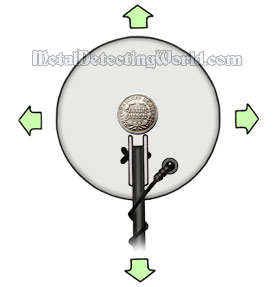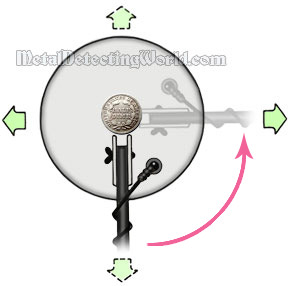Search Coils for Metal Detectors, page 14
Target Pinpointing Techniques for Concentric and Double-D Search Coils
(...CONTINUED from previous page)
Target Pinpointing Techniques for Concentric and Double-D Search Coils

The pinpointing technique depends on the type of a search coil you use. With the concentric search coil, you scan the target in perpendicular directions as shown in illustration on the right. Move the coil in the east to west direction first, slow the sweep rate down and gradually shorten the distance the coil travels over the target area.
Watch the center of the coil as you move the coil and stop it when the coil center coincides with the highest volume and pitch of audio tone. At this stopping point, move the coil in the north to south ("toe to heel") direction repeating the above procedure. Do so without losing the first center obtained in the east to west direction.
When center is achieved, and the search coil is stopped again, train your eyes on this point. Without moving your eye contact with this center reference, slide the search coil away from the target area.
Your eyes should then be focused on a spot on the ground around which you will cut the ground to form a round or square dirt plug and then pull it out.
I should mention that the concentric search coil's electronic center - the region of the most concentrated electromagnetic field (described on page 10), may not correspond to the actual physical center of the search coil. This may depend on either the design or/and construction accuracy of the search coil. However, today's solid style concentric search coils are wound and aligned quite accurately, and their true electronic center is close to physical center.
If you wish to locate the electronic center of your detector's solid style search coil, remove all personal jewelry, and bench test a small coin in the all-metal mode. Your first objective is to get the smallest sound from the coin as if you are detuning the coin signal. Then you move the coin using the pinpointing procedure outlined above until you locate the center in two directions.
Using a waterproof marker, trace the coin's perimeter on the search coil bottom. Measure and transfer the dimensions of the outlined center to the top of the search coil. Make a mark on the transferred center large enough to be seen from a distance.
Obviously the above information is not applicable to search coils that have open centers. The open-center style search coil gives the detectorist added advantage with respect to immediate ground reference during pinpointing. However, the detectorist must judge target audio center to a non-physical search coil center.
Pinpointing with Double-D search coil requires an altered method because of its different detection pattern (described on pages 3 and 11). Because this type of coil has an elongated detection pattern in the "toe to heel" direction, target centering is not as easily accomplished as it is from from side to side for some detectorists.
When you have centered in the east to west direction, rotate your stance position 90 degrees around that center. Repeat the east to west or side to side pinpointing procedure. The target should then be more accurately aligned with the search coil's center marking.
Perpendicular Double-D Search Coil Position during Pinpointing
